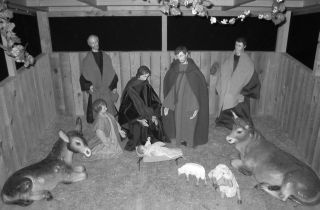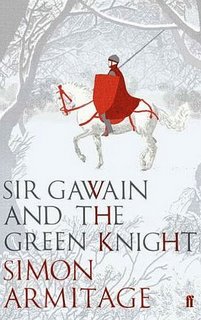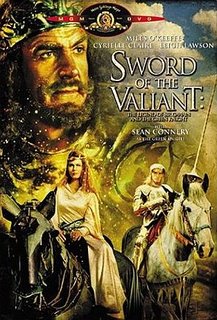-Mary is to have a baby!
-And when will He be born?
-On Christmas Day!
 Even translating the play into the mass medium of film hasn’t helped much. The failure this Xmas of a Hollywood film of The Nativity Story, made under that generic name, to do more than preach to the converted indicates the problem is not simply one of declamatory, over-expository dialogue or amateur production. (In the clips I saw on TV, the dialogue was realistic, and there was expensive location filming.) Over the years, there have been other attempts at producing films of the story, with as little success. Here, in the south-central region of England where I live, a pair of such dramas were shot some years ago. (Dorset’s quarries and beaches are often used by TV producers to represent desert countries.) Shown on ITV as well as in churches around the world, these films were produced by Lady Madeline Lees of South Lytchett Manor using a largely professional crew, and costumes and gear brought back from Tibet by her late associate, the distinguished diplomat and mystic Sir Francis Younghusband. Voice In The Wilderness (1957), the story of St John the Baptist, and its follow-on Messiah, were produced to promote "World Peace Through Religious Drama" and `catch the Teddy boys by surprise' by using modern idioms. Though similar silent dramas had been made by churches elsewhere, this 1950s enterprise was doomed due to increasing audience sophistication. Patrick French's 1994 biography Younghusband notes: "The films are remarkably well made considering the circumstances of their creation, with crowd scenes of up to three or four hundred people. Yet they both bear an unforeseen but undeniable resemblance to Monty Python's Life Of Brian, as men with funny beards and tea-towels charge about the Dorset countryside on Chipperfield circus camels, singing 'Silent Night' and pretending they are in the Holy land."
Even translating the play into the mass medium of film hasn’t helped much. The failure this Xmas of a Hollywood film of The Nativity Story, made under that generic name, to do more than preach to the converted indicates the problem is not simply one of declamatory, over-expository dialogue or amateur production. (In the clips I saw on TV, the dialogue was realistic, and there was expensive location filming.) Over the years, there have been other attempts at producing films of the story, with as little success. Here, in the south-central region of England where I live, a pair of such dramas were shot some years ago. (Dorset’s quarries and beaches are often used by TV producers to represent desert countries.) Shown on ITV as well as in churches around the world, these films were produced by Lady Madeline Lees of South Lytchett Manor using a largely professional crew, and costumes and gear brought back from Tibet by her late associate, the distinguished diplomat and mystic Sir Francis Younghusband. Voice In The Wilderness (1957), the story of St John the Baptist, and its follow-on Messiah, were produced to promote "World Peace Through Religious Drama" and `catch the Teddy boys by surprise' by using modern idioms. Though similar silent dramas had been made by churches elsewhere, this 1950s enterprise was doomed due to increasing audience sophistication. Patrick French's 1994 biography Younghusband notes: "The films are remarkably well made considering the circumstances of their creation, with crowd scenes of up to three or four hundred people. Yet they both bear an unforeseen but undeniable resemblance to Monty Python's Life Of Brian, as men with funny beards and tea-towels charge about the Dorset countryside on Chipperfield circus camels, singing 'Silent Night' and pretending they are in the Holy land."The irony of all this is that there is a short play, regarded as a masterpiece, that was written as Christian PR to be performed over the Xmas holidays (when it is set), but rarely performed today. Most people would have encountered it through a film, TV or radio version [see note at end] rather than stage performance. This “masterpiece of medieval English romance … combines the sturdiness of epic, the fantastic charm of romance, and the sophistication of a country-house novel.” Surviving as a single manuscript of circa 1360-70, by an unknown author, Sir Gawain And The Grene Knyght encodes a triadic framework of pagan mysteries and ritual, presented as tests of Christian virtue. There is the Green Man, the Beheading Test, the Temptation-By-Hostess challenge, the Exchange of Winnings, and so on. (Today it would be titled something like “The Knight, The Quest, The Magician And His Lover.”)
 It is set over two yearend-holiday periods a year apart. (In the poem it is called Christmastide, a period of feasting and merriment which lasted until Twelfth Night.) A young knight undertakes a challenge which will test his virtue as well as his courage, and passes the various tests after he confesses his own imperfections. Like other Arthurian Romances, it is a matrix of Celtic, Nordic, Christian and other cultural motifs. (Tolkien co-edited the first mass-market translation.) Unlike other Romances, it ties its elements up into a single narrative conception, a cohesive story told in 101 stanzas of alliterative Middle English. It also brought something new, a gentle humour (in the seduction scenes). In a ‘trickster’ plot of the sort that today would be written by Anthony Shaffer, it blends courtly romance, pagan ritual, and Christian piety to tell a moral tale about nobility, chivalry and humility, and the importance of pledges, bargain-keeping, and always telling the truth. Generically, this would be, rather than a ‘Xmas Nativity Play,’ what we might call a ‘Xmas Nobility Play.’
It is set over two yearend-holiday periods a year apart. (In the poem it is called Christmastide, a period of feasting and merriment which lasted until Twelfth Night.) A young knight undertakes a challenge which will test his virtue as well as his courage, and passes the various tests after he confesses his own imperfections. Like other Arthurian Romances, it is a matrix of Celtic, Nordic, Christian and other cultural motifs. (Tolkien co-edited the first mass-market translation.) Unlike other Romances, it ties its elements up into a single narrative conception, a cohesive story told in 101 stanzas of alliterative Middle English. It also brought something new, a gentle humour (in the seduction scenes). In a ‘trickster’ plot of the sort that today would be written by Anthony Shaffer, it blends courtly romance, pagan ritual, and Christian piety to tell a moral tale about nobility, chivalry and humility, and the importance of pledges, bargain-keeping, and always telling the truth. Generically, this would be, rather than a ‘Xmas Nativity Play,’ what we might call a ‘Xmas Nobility Play.’The good news is that this Xmas it got an airing on BBC radio, as a Radio 4 play narrated by Ian McKellen, translated from the mediaeval verse by Simon Armitage, and that there is a book [pictured above] of his adaptation. If your browser can read Title tags, hover your mouse on the cover above for a sample descriptive passage from his translation, of winter.
Available Adaptations: The original is written in a Lancashire dialect of Middle English by a contemporary of Chaucer, in the decade ME officially replaced Norman French as the language of court, but modernised translations are available. The text was published in the 1970s as a Penguin Classics paperback (how most people, including myself, first encountered it). There are other translations e.g. by Tolkien still available, and the original Middle English version is now available online also. The new translation by Simon Armitage is due out January 4th.
 On screen, there was a 1973 British film version shot in Wales, [Sir] Gawain and the Green Knight, directed by Stephen Weeks, with Murray Head as Gawain and a dubbed Nigel Green as the Green Knight, which is said to have been the inspiration for Monty Python And The Holy Grail. It does not seem to be available. A 1984 US-financed remake shot in Wales and France by the same director, with Miles (Tarzan) O'Keeffe as Gawain and Sean Connery as the Green Knight was retitled, to avoid confusion, Sword Of The Valiant: The Legend Of Gawain And The Green Knight. This seems to have added elements from other Arthurian romances, and then been heavily cut after its premiere. It is available on DVD, though not in original director’s-cut widescreen version. There was also Gawain, a 1991 film of Sir Harrison Birtwhistle’s opera, available on CD. The Tolkien version is also available on audio cassette. On radio, the Xmas 2006 Simon Armitage BBC Radio 4 dramatisation mentioned, may be available via BBC’s Listen Again listen-on-demand service, and is a likely contender for broadcast on the World Service.
On screen, there was a 1973 British film version shot in Wales, [Sir] Gawain and the Green Knight, directed by Stephen Weeks, with Murray Head as Gawain and a dubbed Nigel Green as the Green Knight, which is said to have been the inspiration for Monty Python And The Holy Grail. It does not seem to be available. A 1984 US-financed remake shot in Wales and France by the same director, with Miles (Tarzan) O'Keeffe as Gawain and Sean Connery as the Green Knight was retitled, to avoid confusion, Sword Of The Valiant: The Legend Of Gawain And The Green Knight. This seems to have added elements from other Arthurian romances, and then been heavily cut after its premiere. It is available on DVD, though not in original director’s-cut widescreen version. There was also Gawain, a 1991 film of Sir Harrison Birtwhistle’s opera, available on CD. The Tolkien version is also available on audio cassette. On radio, the Xmas 2006 Simon Armitage BBC Radio 4 dramatisation mentioned, may be available via BBC’s Listen Again listen-on-demand service, and is a likely contender for broadcast on the World Service.There is a review of the new Simon Armitage version here (“a translation to be savoured for its own linguistic merits”).
Update: There's a review of the Simon Armitage book in The Observer, which is also selling the book online.





